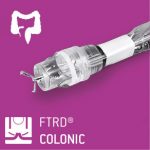Hybrid FTRD case series: Promising results for patients with invasive tumors
First prospective series of patients with invasive tumors to be treated with hybrid pEMR-EFTR reveals promising results
Evaluation of a case series showed that the hybrid resection technique using piecemeal endoscopic mucosal resection and endoscopic full-thickness resection (pEMR-EFTR) is a promising noninvasive treatment modality for patients with large colonic laterally spreading tumors (LSTs > 20 mm) containing only one small (< 20 mm) and well-demarcated area of suspected T1 CRC.
Combining EFTR with other treatment modalities, such as snare polypectomy or pEMR, have recently been proposed to be useful for resection of large and complex colorectal tumors. In a current case series, Chua et al. reported on the treatment of colonic LSTs containing a small (< 20 mm) focus of submucosally invasive colorectal cancer (T1 CRC) using hybrid p-EMR-EFTR in a single session.
Patient cases were analyzed from a Dutch multicenter EFTR registry between July 2015 and December 2019. In total, six patients with a large LST containing suspected T1 CRC were treated with hybrid pEMR-EFTR. All lesions were judged as having one well-demarcated focus of T1 CRC, with a median size of 12.5mm (range 5–20). Indications for hybrid pEMR-EFTR were inoperability due to comorbidity and/or frailty (n=2), refusal of surgery (n=2; oncological surgery for CRC in the past), and preference of endoscopic treatment over surgical resection after medical consultation (n=2). For all patients, endoscopic submucosal dissection (ESD) was not considered feasible by the treating endoscopist, mainly because of the relatively high risk of perforation.
Hybrid pEMR-EFTR was started with submucosal injection and snare polypectomy of the benign parts of the polyp to isolate the invasive part of the polyp. Afterwards, the FTRD System was used for EFTR of the suspected invasive part (according to standard procedures).
In all cases, isolation of the invasive part of the lesion with EFTR was successful. Technical success of EFTR was 100 %. Histologically complete resection of the invasive part with EFTR was achieved in 5/6 patients (83.3 %). No adverse events occurred during or after the procedure. All patients stayed one night in the hospital for observation and were discharged the next day. The median follow-up time was 10 months (range 6–27), with all patients having undergone ≥ 1 surveillance colonoscopy. One patient had a small adenomatous recurrence, which was removed endoscopically.
Chua et al. concluded that hybrid pEMR-EFTR seems a promising noninvasive treatment option for a selected group of patients with large LSTs (> 20 mm) containing only one small (< 20 mm) and well-demarcated area of suspected T1 CRC. Furthermore, they consider the technique particularly useful for patients with tumors located in the right hemicolon, who are at high risk of adverse events from surgery as well as from ESD.
Hybrid endoscopic mucosal resection and full-thickness resection for large colonic polyps harboring a small focus of invasive cancer: a case series
Chua JS, Dang H, Zwager LW, Dekkers N, Hardwick JCH, Langers AMJ, van der Kraan J, Perk LE, Bastiaansen BAJ, Boonstra JJ; Dutch eFTR Working Group.
Endosc Int Open. 2021 Nov 12;9(11):E1686-E1691.
ncbi.nlm.nih.gov/34790531/
 |
 |


 Deutsch
Deutsch  Français
Français 